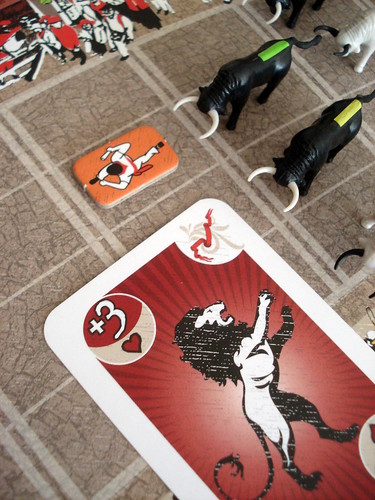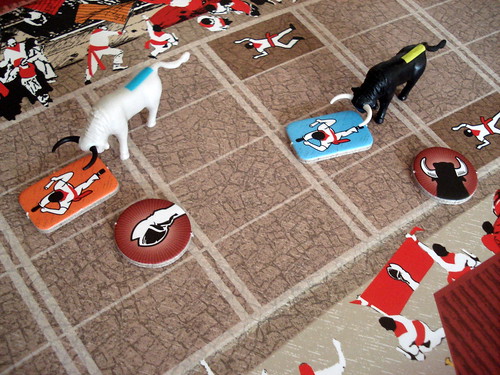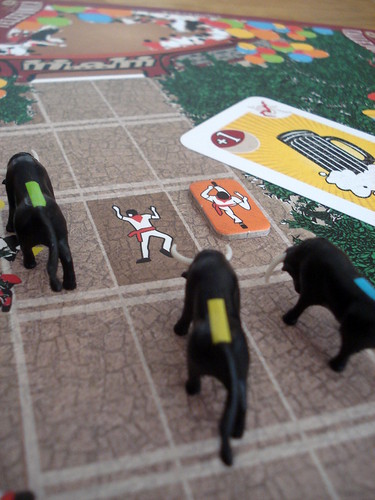| Strategy | Luck |
|---|---|
| Interaction | Components & Design |
| Complexity | Score |

Let me get this out of the way first, and at the risk of getting some people angry at me: I’m not personally a big fan of the encierro. I get that it’s an important cultural event, but I disagree with driving a herd of panicked animals through the city and then killing half of them in the bullring later that day. I disagree with it, but I don’t let it get in the way of my boardgaming: it’s not real bulls, it’s not real people being gored to death by them – did I mention you gore people in Pamplona? – and we can all separate game from reality.
It should be abundantly clear by now that when you’re playing Pamplona – Viva San Fermín you’re running in the encierro. But your concern is not just to get your runner to safety first. You’re playing for both teams here with one runner, one bull and one steers in the race and your goal is to make it to the finish line alive while also goring and trampling your opponents. It would be rather tedious to check for genitals each time to figure out which of your cow miniatures is a bull and which is a steers, so for convenience’s sake bulls are black and steers are white. I’m grateful for that distinction, a game that has me looking at cow testicles – or their absence – every turn might have been too much for my tolerance. The race is run in four short stages that differ slightly in length and in where trampled people are already on the ground, slowing you down. There may be a hint of bad taste in the details.
Each stage starts with the bulls and steers entering the field. To move them, you have two different sets of hand cards – black ones for bulls, white ones for steers- showing numbers from two to five with the bulls being lightly faster on average. The longer stages are only 15 squares long, so playing a five means you’re one third along the street already. When all bovines are on the board it’s time to enter the runners. Pamplona catches the essence of the bull run here, it’s all about proving your manliness and courage: you pick a place to start somewhere in front of the bulls and the closer to the first bull you start the more prestige – aka victory points – you will gain if you make it across the finishing line. The maximum here is five points, and on top of that you can gain three more points for starting right in front of the very first bull.

The race itself is about as easy as these things can get: starting from the front of the pack, each runner – be it bull or human – makes a move. When two runners are on the same line then the one on the right side of the track moves first – keep that rule in mind, it’s essential for your survival. Bulls and steers move with their respective cards, runners get a fixed to squares per turn and everyone can only move forward, straight or diagonally. There is no moving sideways and no going backwards – understandable when you have about 10 tons of enraged beef running behind you. Steers and bulls are faster and they are pointy at one end, so sooner or later the human runners will be in trouble: when a steer enters a square with a runner from directly behind – diagonally won’t do – it awards a hoof token worth one victory point to its owner and tramples its victim. I imagine that to be excruciatingly painful, but real men will just get up the next turn and keep running. Bulls, on the other hand, gore runners with their horns. For the bull’s owner that’s even better: horn tokens are worth two victory points. For the human runner being gored is less fortunate: no amount of testosterone will keep you moving after a horn went through your abdomen, gored runners are out of the game for this stage, to be replaced by their twin brother for the next. On first reading the rules, the strategic options here seem limited: keep moving with your runner, hide behind fallen runners because bulls and steers must stop on them, attack people with your commando cows. During the first game another very important option becomes apparent: you can use your own bulls and steers to protect your runner. Park them on the square behind the squishy and no one else can harm him.

And that’s not all yet, you also have your special cards to use. Three special cards are the same for every player: two mugs of beer and the Blessing of San Fermín. The blessing you use at the beginning of a stage and it will protect you from the first goring you receive. Beer either makes your runner faster for one turn or can be exchanged for an additional one of the other, unique special cards. Of those special cards each player picks one at the beginning of the stage – plus the ones for a beer, if he so chooses – and they can all be used once in that stage. Most of them affect your runner and allow him, for example, to jump on the drain pipes if he’s at the outside of the track, protecting him from the next rampaging ruminant. Or to sprint four squares in one turn after drinking a Carajillo – coffee with rum. Other cards let your steer gore your opponents as if they were bulls or allow your bull to move backwards and sideways.
It would be going too far to call Pamplona – Viva San Fermín a deep game, but in its very tight focus of maximizing the points for your runner, escaping unfriendly ungulates and goring other runners to death it’s actually very strategic. Using your special cards to the best effect is key here, of course, but even with them winning the eight points for starting right in front of the first hostile holstein is not an easy feat. At least for us, the game turned out to be less violent than we expected. People do get trampled and gored – and if that is too much in bad taste for you then you won’t enjoy Pamplona much, anyway – but it’s not so easy to get your opponents caught under the stampede, and quite often it’s not the most profitable move for you, either. Instead, using your cows defensively is often worth more points in the end. And as a game of Pamplona – Viva San Fermín only takes around 30 minutes – that’s still about eight times as long as the real encierro – the strategic focus and the options you have are enough to keep you engaged and entertained. Especially when playing with three or four people, in two the streets are a bit too deserted to make the game challenging. Pamplona is also a nice game to look at, the combative cattle is included as plastic sculptures and all other components are high quality and with an illustration style that goes very well with the theme. If you’re not put off by the theme, either because of animal treatment issues or because people get liquidated by lethal livestock, then you can have a very fun, quick game with enough strategy to draw you in.








